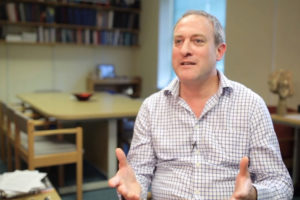Mutation, Selection and Genetic Drift
Biologist Shamil Sunyaev on the sources of genetic variance, reconstructing population history, and disease ri...
What is sensory rhodopsin and how does it work? How are cellular and hormonal signals related? Why is it difficult to study G-protein-coupled receptors? Biophysicist Georg Büldt sheds a light on these interesting questions.
If the bacteria are swimming in water and there is too much light, then the DNA of these bacteria might get defects from the UV light. Then, to protect it, the organism has made this sensory rhodopsin to swim away. When many photons are coming to this protein, the bacteria knows ‘Aha! There is too much light!’. But how does it do that? It gives a signal to the kinase, and the kinase phosphorylates another protein, which goes to a motor of the swimming behaviour. When several of these bind, bacterium then swims in another direction. It’s a fantastic simple thing that uses information that is coming from the outside, the light; evolutionary it was these bacteria, that have developed this system to protect themselves – to swim another way. These things happen in the cell every day. There are 800, say, G-protein-coupled receptors and they do similar things. They give a signal to the nucleus of the cell and then the nucleus will react on that by switching off a protein or decreasing protein production depending on what the signal is. This, of course, is really what we need to survive.
So far it was very difficult, in the eukaryotic cell, to follow up all the different proteins that give a signal to the nucleus. At many cases, there are up to 10 protein in this transport system of the communication to the nucleus. And you must find out how they interact with each other. But what is even more complicated, that if, say, you have 10 of these G-protein-coupled receptors they all have their signalling pathways with different proteins and these different proteins also interact with each other. So, you can see it is really complicated until we really understand how the whole system works.
The Nobel Prize in 2014 was given to people who put forward the method of single molecule fluorescence microscopy. This is also a really fantastic method because nowadays we see the development of good detectors for light. We can see a single fluorescently-marked protein in the cell. Can you imagine? We like to inject into the cell a certain protein which is marked with a fluorescent label. Why we do this? We want to see where it is going and where it is binding. So we inject it and then, under the microscope we can see how it is going through all these other particles in the cell. Because this is the fluorescence that our detectors are very sensitive to. And then we see it binds there and there. For instance, if you want to study communication line to the nucleus, you have to mark, say, two proteins – one with a red label, other with a blue label and then you can see when they come together and whether they come together. So you can find out whether they have interaction. So we, for instance, are studying how protein is going into the mitochondria, into the inner mitochondrial matrix. And that is important because the mitochondria have their own ribosomes where they can make proteins, but many proteins are made outside ribosomes and we want to find out how they come into the matrix.

Biologist Shamil Sunyaev on the sources of genetic variance, reconstructing population history, and disease ri...

Neuroscientist Neil Burgess on the difference between short-term and long-term memory, phonological loop, and ...

Biogerontologist David Gems on the senescence, medical approach to aging and how can you research the fundamen...